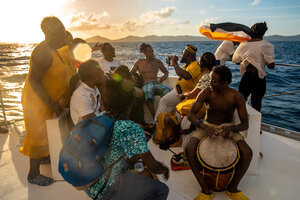For descendants of Black Caribs, this heritage sail is about resilience

JOURNEY OF REMEMBRANCE: The Garifuna travel on a boat returning to Arnos Vale, St. Vincent, from Baliceaux island, where thousands of their ancestors died.
Seth Berry
Baliceaux, St. Vincent and the Grenadines
In 1796, after years of war with the British on St. Vincent, about 5,000 Black Caribs, whose descendants are now known as the Garifuna, were exiled to nearby Baliceaux island. Almost half of them died there because of disease and starvation; the rest were sent to Roatán island in Honduras and spread out along the Central American coast of the Caribbean.
Every March, the Garifuna make a pilgrimage from mainland St. Vincent to Baliceaux. The annual journey is a method of paying tribute to and connecting with their ancestors – as well as an effort to keep the unique culture alive on St. Vincent, teaching young people the Garifuna language and music.
This year, a group of descendants making the hourlong trip by catamaran sits solemnly as the choppy sea crashes against the hull. Their eyes are focused on the coastline of Baliceaux. When the boat reaches the shore, the passengers – from countries including Honduras, Belize, Guatemala, and the United States – jump onto the beach and encircle a large bowl of burning incense. They intertwine fingers and begin a ritual song to bless the land.
Why We Wrote This
For the Garifuna, a journey to the island to which their descendants were exiled is as much about standing strong today as it is about remembering the past.
“It’s the moment my feet touch the water, then the beach. I feel at home. I feel enveloped by my ancestors,” Queen Mother Freda Sideroff says. She is originally from Belize, but the Republic of Cameroon awarded her the title “queen mother” based on her ancestral connections. She now lives in the U.S., home to a third of the 600,000 members of the global Garifuna diaspora, and is the founder of the Garifuna International Indigenous Film Festival.
After the song concludes, the descendants assemble under the shade of a small tree and begin to beat traditional drums and blow into emptied conch shells. The buyei, the spiritual leader, shakes maracas and leads the group members to face each cardinal direction, making their presence known to the ancestors.
Later, as the group of some 60 pilgrims makes its return on the catamaran from Baliceaux back to St. Vincent, Garifuna musicians from New York break out into song – in a new rhythm they say was communicated by their ancestors. As the sun drops into the sea and the catamaran sways from side to side, the thumping of the drums rings out across the water. The chants declare a sense of pride and strength.
“We are confronting our own resilience,” Queen Mother Freda says. “And we are still standing strong.”
For more visual storytelling that captures communities, traditions, and cultures around the globe, visit The World in Pictures.

